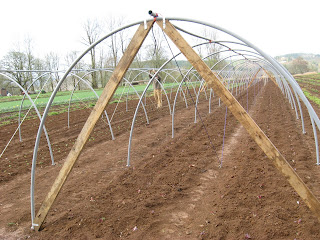Having spent a full half hour trying to craft a clever introduction to the following quotes, I give up. They stand alone; thoughtful, timely and inspiring.
"The class principally defective is that of agriculture. It is the first in utility, and ought to be the first in respect. The same artificial means which have been used to produce a competition in learning, may be equally successful in restoring agriculture to its primary dignity in the eyes of men. It is a science of the very first order. It counts among it handmaids of the most respectable sciences, such as Chemistry, Natural Philosophy, Mechanics, Mathematics generally, Natural History, Botany. In every College and University, a professorship of agriculture, and the class of its students, might be honored as the first. Young men closing their academical education with this, as the crown of all other sciences, fascinated with its solid charms, and at a time when they are to choose an occupation, instead of crowding the other classes, would return to the farms of their fathers, their own, or those of others, and replenish and invigorate a calling, now languishing under contempt and oppression. The charitable schools, instead of storing their pupils with a lore which the present state of society does not call for, converted into schools of agriculture, might restore them to that branch qualified to enrich and honor themselves, and to increase the productions of the nation instead of consuming them." (TJ to David Williams, L&B.10.429-30)
And another thing:
"Those who labor in the earth are the chosen people of God, if ever He had a chosen people, whose breasts He has made his peculiar deposit for substantial and genuine virtue. It is the focus in which he keeps alive that sacred fire which otherwise might escape from the face of the earth. Corruption of morals in the mass of cultivators is a phenomenon of which no age nor nation has furnished an example." --Thomas Jefferson: Notes on Virginia Q.XIX, 1782. ME 2:229
 We tried unsuccessfully to acquire more grant monies to complete the barn project. We met this winter with our employees and I pitched a number of different projects for the farm to pursue this season. Everyone got behind completing the barn. With limited funds available I begged and pleaded with the contractors, and volunteered myself and dedicated some field crew to try and get the exterior finished. While MDK replaces the shingles we scrape and replace siding and trim.
We tried unsuccessfully to acquire more grant monies to complete the barn project. We met this winter with our employees and I pitched a number of different projects for the farm to pursue this season. Everyone got behind completing the barn. With limited funds available I begged and pleaded with the contractors, and volunteered myself and dedicated some field crew to try and get the exterior finished. While MDK replaces the shingles we scrape and replace siding and trim. MDK finished the East gable today and we have prepped the North and South sides for paint. By the end of next week if the weather cooperates the old girl should have a fresh coat of paint to match the house.
MDK finished the East gable today and we have prepped the North and South sides for paint. By the end of next week if the weather cooperates the old girl should have a fresh coat of paint to match the house.






